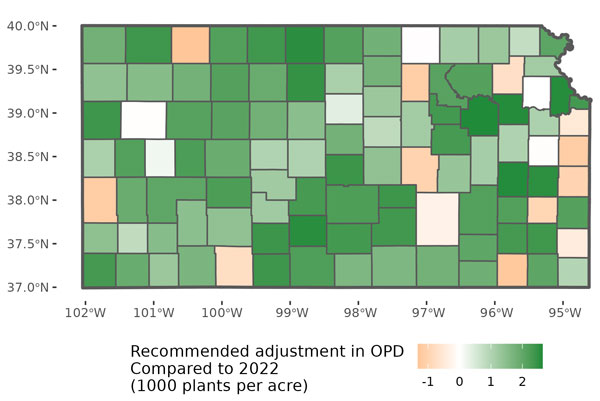As the planting season for corn begins, producers need to decide their corn seeding rates. The plant density necessary to optimize yields (optimal plant density, or OPD) depends on the expected resource availability, primarily water and nutrients. For 2023, the critical factor is linked to the water availability at planting and the expected forecast for this season.
This is why plant density needs to be determined seasonally, depending on the expected growing conditions. In rainy years, a producer may increase the target seeding rate (to obtain a high plant density) and increase potential profit. Under dry conditions, farmers should consider cutting back on plant density. This applies primarily to dryland corn production and could be very relevant for this growing season.
In a previous eUpdate article, we discussed the importance of selecting the right seeding rate under different conditions across Kansas. In fact, we recommended reducing the seeding rate due to the drought forecasts. This year, farmers can get back to normal seeding rates for dryland corn.
The upcoming season is expected to be hotter and slightly above normal for precipitation (2023 outlook in Kansas) in much of the Corn Belt region, thus yield expectations and seeding rates should be adjusted accordingly.
Based on the weather forecasts released in March, farmers that reduced their seeding rates last year should do a minor adjustment to their plant densities this spring (1,000 to 2,000 more plants/acre) due to the expected weather conditions (Figure 1). Farmers that did not reduce their yields last year should operate as usual, using the same target seeding rates.

Figure 1. Change in the forecasted optimum plant density (OPD) for Spring 2023, relative to the optimum plant density for corn in 2022 (dry year) across the region and in Kansas. Colors represent whether the recommended change is to increase (green) or decrease (orange) the target plant density (OPD) from what was used last year. The upper panel shows the potential changes for the Corn Belt region, and the lower panel refers to Kansas's plant density changes.
In summary, 2023 is predicted to be a better season for Kansas, but the start of the season has been challenging with very dry conditions across the state. Farmers who did not reduce their seeding rates should operate as usual. Maintaining a similar seeding rate could be a good target based on the current conditions and the expected forecast.
The utilization of probabilistic and dynamic models such as the one presented here can help producers make real-time decisions to adjust inputs based on current soil moisture conditions and seasonal weather forecasts.
Ignacio Ciampitti, Farming Systems
ciampitti@ksu.edu
Josefina Lacasa, PhD student
lacasa@ksu.edu
Tags: corn seeding rate plant density